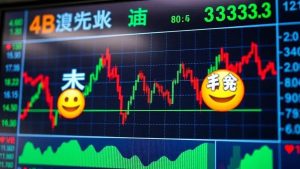Investor confidence decline: what it means for your future

A decline in investor confidence often leads to market volatility and can be mitigated through strategies like diversification, maintaining an emergency fund, and staying informed about market conditions.
Investor confidence decline is not just a buzzword; it can influence your financial choices and the overall market environment. Have you ever considered how your investments might be affected by shifts in investor sentiment? Let’s dive into this crucial topic.
Understanding investor confidence
Understanding investor confidence is crucial in today’s financial landscape. When we talk about investor confidence, we refer to how optimistic or pessimistic investors feel about the market’s future. This sentiment can impact investment decisions significantly, influencing everything from stock prices to overall market stability.
What Factors Influence Investor Confidence?
Several elements play a role in shaping this confidence:
- Economic indicators like unemployment rates and GDP growth.
- Political stability and government policies.
- Market performance and historical trends.
These factors can lead to fluctuations in investor feelings. When confidence is high, investments generally increase, leading to market growth. Conversely, a decline in confidence may trigger panic selling and a downturn.
The Role of Media and Information
The media landscape also significantly impacts how investors perceive market conditions. Information spreads quickly; both positive and negative news can sway sentiment. Investors often react more to news headlines than to underlying economic data. Therefore, understanding the role of media is essential to grasp how perceptions can shift so rapidly.
After all, the conclusions drawn from news reports can have immediate effects on the market. This, in turn, emphasizes the need for investors to be critical consumers of information.
Moreover, behavioral economics suggests that some emotional factors, such as fear and greed, can influence the decisions investors make. During a downturn, fear tends to dominate, leading to a vicious cycle of declining confidence.
Factors contributing to confidence decline

Understanding the factors contributing to confidence decline is essential for investors. Various elements can lead to a decrease in investor confidence, impacting their decision-making. Some of the most significant contributors include economic instability, geopolitical tensions, and market volatility.
Economic Instability
An economy facing downturns, rising unemployment rates, or stagnant growth can trigger investor anxiety. If data shows a weakening economic forecast, many investors may become wary and hesitate to invest further. This hesitance can create a ripple effect, causing prices to drop.
- High inflation rates can erode purchasing power.
- Increased interest rates may deter borrowing.
- Uncertainty in job markets can lead to reduced consumer spending.
The impact of such factors isn’t just theoretical; they play a pivotal role in shaping investor sentiment and market dynamics.
Geopolitical Tensions
Conflicts or tensions between nations can lead to uncertainty and fear in the investment landscape. Events like wars or diplomatic disputes can cause markets to react negatively. Investors often seek stability and may pull back from investing when faced with threats of conflict.
The overreliance on international markets can amplify this effect. For example, if a major trading partner faces instability, it can lead to broader market fears. This interconnection makes it critical for investors to monitor global events closely.
Historical examples of market reactions
Exploring historical examples of market reactions reveals how investor confidence has shaped financial markets over time. Significant events can cause immediate and dramatic changes in market behavior, providing valuable lessons for today’s investors.
The Dot-Com Bubble
In the late 1990s, the technology sector experienced explosive growth. Investors were eager to invest in internet-based companies, driven by excitement and hype. However, this irrational confidence ultimately led to the dot-com bubble, which burst in 2000. Many companies went bankrupt, and stock prices plummeted.
- Companies like Pets.com became famous examples of unsustainable business models.
- The NASDAQ index dropped from around 5,000 to less than 2,000.
- This event showed how unchecked confidence could lead to grave financial consequences.
As a result, investors began to approach new technology investments with more caution in subsequent years.
The 2008 Financial Crisis
The 2008 financial crisis stands as another pivotal moment illustrating the impacts of declining investor confidence. This crisis was sparked by a collapse in the real estate market, primarily due to subprime mortgage lending. The roots of the crisis lay in a lack of trust in complex financial instruments.
As the crisis unfolded, investors lost confidence, leading to a significant stock market decline. Major financial institutions faced bankruptcy, and the crisis resulted in global economic turmoil.
- The Dow Jones Industrial Average fell more than 50% from its peak.
- Many investors were left scrambling to manage their portfolios.
- This crisis served as a reminder of the importance of transparency and risk assessment in investment decisions.
These historical examples demonstrate how quickly investor confidence can change and influence market dynamics, reminding us to stay informed and vigilant.
How to mitigate risks during a decline

Mitigating risks during a market decline is crucial for protecting investments. When facing uncertainty, having a solid strategy can make a significant difference in how financial portfolios are managed. Investors need to be proactive and informed to navigate these challenging times.
Diversification of Investments
Diversification is one of the most effective ways to reduce risk. By spreading investments across various asset classes, investors can lower their exposure to any single market downturn. This approach protects against volatility in any one sector.
- Invest in a mix of stocks, bonds, and real estate.
- Consider international markets to diversify geographical risks.
- Include different industries to buffer against sector-specific declines.
This strategy helps maintain stability, even when certain areas of the market are underperforming.
Staying Informed and Responsive
Being well-informed is vital during periods of decline. Investors should actively monitor economic indicators, market trends, and news impacting their investments. Quick responses to changing circumstances can help mitigate risks.
Creating a watchlist of reliable information sources assists in staying current. Moreover, developing a plan for investment actions when certain thresholds are reached can help maintain focus. This way, investors are less likely to make impulsive decisions based on emotions.
Utilizing Stop-Loss Orders
Stop-loss orders can act as a safety net, allowing investors to set predetermined exit points for their investments. This tool helps prevent further losses during a market downturn by automatically selling assets when they reach a specified price.
Implementing this strategy provides reassurance for investors, helping them stick to their risk tolerance levels even in uncertain times. By establishing these parameters, it is easier to avoid more significant emotional decisions that may occur during market panic.
Strategies for navigating uncertain markets
When it comes to navigating uncertain markets, having effective strategies is essential for investors. Uncertainty can lead to confusion and fear, but a well-thought-out plan can help mitigate risks and guide investment decisions.
Keep a Long-Term Perspective
Maintaining a long-term perspective is critical. Short-term market fluctuations can be overwhelming, but focusing on long-term goals helps investors remain calm during volatility. Investing with a horizon of five years or more allows for greater risk tolerance.
- Consider the overall growth of your investments over time.
- Resist the temptation to react impulsively to daily market changes.
- Stay committed to your investment strategy.
By focusing on long-term objectives, investors can avoid making hasty decisions in reaction to market dips.
Establish an Emergency Fund
Creating an emergency fund is another key strategy. This fund acts as a financial safety net during uncertain times. Having readily available cash can reduce the need to sell investments at decreased values during downturns.
The emergency fund should ideally cover three to six months’ worth of living expenses. This cushion provides peace of mind and allows investors to navigate market uncertainties without financial stress.
Regularly Review and Adapt Your Portfolio
Regular portfolio reviews are important to ensure that investments align with personal goals and market conditions. An adaptable approach means being willing to ~reallocate and make changes when necessary.
Investors should periodically assess their portfolios and adjust based on their financial situation, risk tolerance, and the economic landscape. This proactive management can help in navigating through periods of uncertain markets.
The future outlook for investors

The future outlook for investors is shaped by various trends and developments in the financial landscape. Understanding these trends can help investors make informed decisions as they navigate potential opportunities and challenges.
Technological Advancements
Technological advancements are transforming investment strategies. Innovations like robo-advisors and algorithm-driven trading are making investing more accessible and efficient. Investors can now utilize AI tools to analyze market data and make informed decisions quickly.
- Robo-advisors provide automated portfolio management.
- Algorithmic trading enhances trading speed and accuracy.
- Data analytics tools help uncover market trends.
These technologies are enabling a broader range of individuals to participate in the investment market, potentially increasing competition.
Sustainability and Ethical Investing
There is a growing trend toward sustainability and ethical investing. Investors are increasingly considering environmental, social, and governance (ESG) factors when making decisions. This shift indicates a preference for companies that prioritize responsible practices.
For many investors, aligning their portfolios with their values is essential. This focus on sustainability is not just a passing trend; it suggests that demand for responsible investments will likely increase in the future.
Market Volatility and Economic Uncertainty
While opportunities exist, investors should remain cautious of market volatility and economic uncertainty. Global economic indicators, geopolitical tensions, and unexpected events can create sudden shifts in the market landscape.
Understanding how to respond to such volatility will be crucial. Investors must stay informed about global events and market trends to adapt their strategies effectively. Preparing for downturns while seeking growth opportunities can lead to a balanced approach for long-term success.
FAQ – Frequently Asked Questions Regarding Investor Confidence and Markets
What factors affect investor confidence?
Investor confidence can be influenced by economic indicators, geopolitical events, market performance, and technological advancements.
How can I mitigate risks during market declines?
To mitigate risks, diversify your investments, maintain an emergency fund, and consider using stop-loss orders.
What role does technology play in investing?
Technology enables better data analysis, automated trading, and provides access to various investment opportunities, improving decision-making.
What is ethical investing?
Ethical investing involves choosing investments based on environmental, social, and governance criteria, aligning financial goals with personal values.






